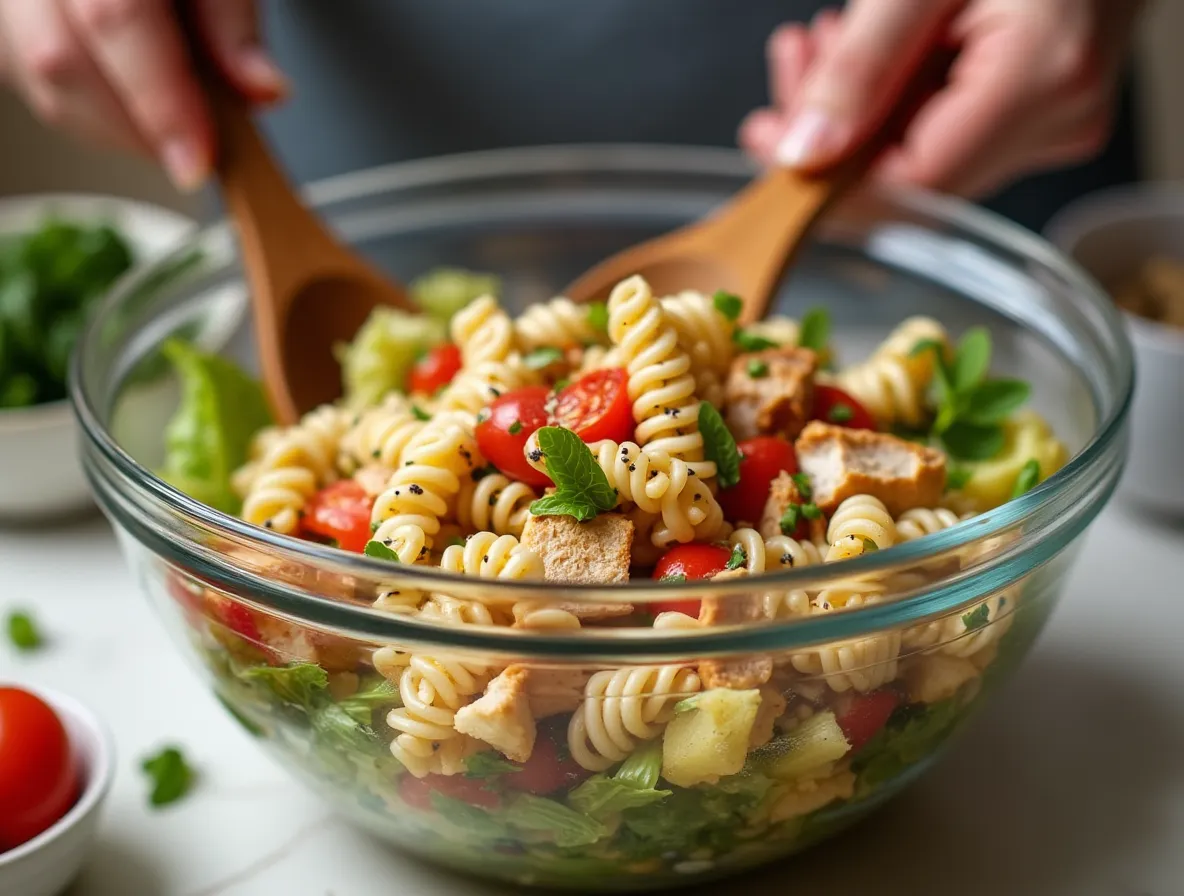Introduction
In today’s fast-paced world, finding meals that are both nutritious and convenient can be a challenge. Enter the High Protein Pasta Salad—a dish that seamlessly blends taste, health, and ease of preparation. Whether you’re aiming to fuel your workouts, manage your weight, or simply enjoy a satisfying meal, this pasta salad checks all the boxes.
Unlike traditional pasta salads that are often carb-heavy and protein-light, this version leverages high-protein ingredients like chickpea pasta, lean meats, and nutrient-rich vegetables. The result? A balanced meal that keeps you full longer, supports muscle maintenance, and delights your taste buds.Nourishing Niki
Moreover, the versatility of this dish allows for endless customization. Whether you’re vegetarian, gluten-free, or following a Mediterranean diet, there’s a variation that suits your needs.
In this comprehensive guide, we’ll delve into the benefits of high protein pasta salads, explore various ingredient options, provide step-by-step preparation instructions, and share expert tips to elevate your salad game. Let’s embark on this culinary journey to discover the perfect blend of health and flavor.
Table of Contents
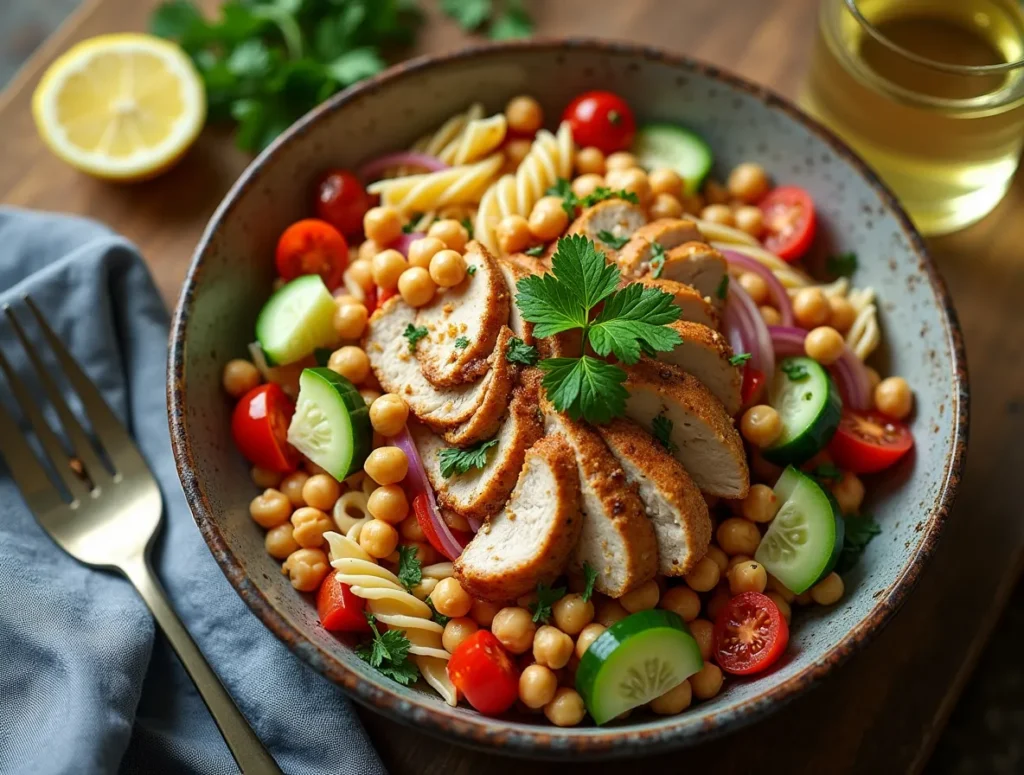
Why Choose High Protein Pasta Salad?
Nutritional Powerhouse for Every Lifestyle
High protein pasta salad isn’t just a trendy lunch option—it’s a well-rounded, nutrient-dense meal. The main star, protein, plays a vital role in building and repairing tissues, supporting metabolic functions, and maintaining lean muscle mass. Whether you’re a fitness enthusiast, a busy parent, or someone trying to manage their weight, increasing your protein intake can significantly impact your health.
Pairing protein with complex carbs and fiber-rich veggies also slows digestion, which helps regulate blood sugar levels and keeps you feeling full longer—reducing the urge to snack between meals. This makes it an excellent choice for those following diets like keto (with adjustments), Mediterranean, or high-protein plans.
Ideal for Meal Prep and Busy Lifestyles
Another major perk of high protein pasta salad is its convenience. It can be made in bulk, stored in the fridge for days, and easily packed for lunches, picnics, or post-workout fuel. Unlike some meals that lose flavor or texture over time, pasta salad often tastes better the next day after the flavors have had time to meld..Mango Salsa Recipe
It’s also a one-bowl wonder—less cleanup, more satisfaction. Busy professionals, college students, and meal-preppers alike will find this dish to be a lifesaver.
Key Ingredients for the Ultimate High Protein Pasta Salad
High-Protein Pasta Options
To make your pasta salad truly protein-packed, swap traditional white pasta for higher-protein alternatives such as:
- Chickpea Pasta: A gluten-free option that offers 12–15g of protein per serving.
- Lentil Pasta: Dense in plant-based protein and fiber, great for vegans.
- Quinoa Pasta: Rich in protein and contains all nine essential amino acids.
- Whole Wheat Pasta: Not as high in protein as legume-based pastas, but better than refined versions.
Lean Proteins to Add Bulk and Flavor
To bump up the protein content even further, mix in any of the following:
- Grilled Chicken Breast: Lean, versatile, and a great source of complete protein.
- Canned Tuna or Salmon: Adds Omega-3s along with protein.
- Hard-Boiled Eggs: Affordable and easy to prepare in advance.
- Tofu or Tempeh: Excellent for plant-based diets; can be seasoned and grilled.
- Edamame or Black Beans: Boosts protein and adds texture.
Fresh Vegetables for Crunch and Nutrients
Vegetables not only enhance the visual appeal but also offer a wide array of vitamins, minerals, and antioxidants. Consider these for a colorful, nutrient-rich dish:
- Cherry tomatoes
- Bell peppers
- Red onions
- Cucumbers
- Carrots
- Baby spinach or arugula
- Roasted zucchini or eggplant
Dressing That Ties It All Together
A great pasta salad is only as good as its dressing. Here are some healthy and protein-friendly options:
- Greek Yogurt-Based Dressing: Adds creaminess and protein.
- Balsamic Vinaigrette: A classic that’s low in calories and high in flavor.
- Tahini Lemon Dressing: Creamy, nutty, and rich in plant protein.
- Avocado Lime Dressing: Healthy fats and bold flavors.
Add-Ons and Boosters
Elevate your salad’s taste and texture with:
- Feta or Goat Cheese: Adds tang and calcium.
- Pumpkin Seeds or Sunflower Seeds: For crunch and healthy fats.
- Olives or Capers: Bring a briny kick.
- Fresh Herbs: Parsley, dill, or basil to freshen up the palate.
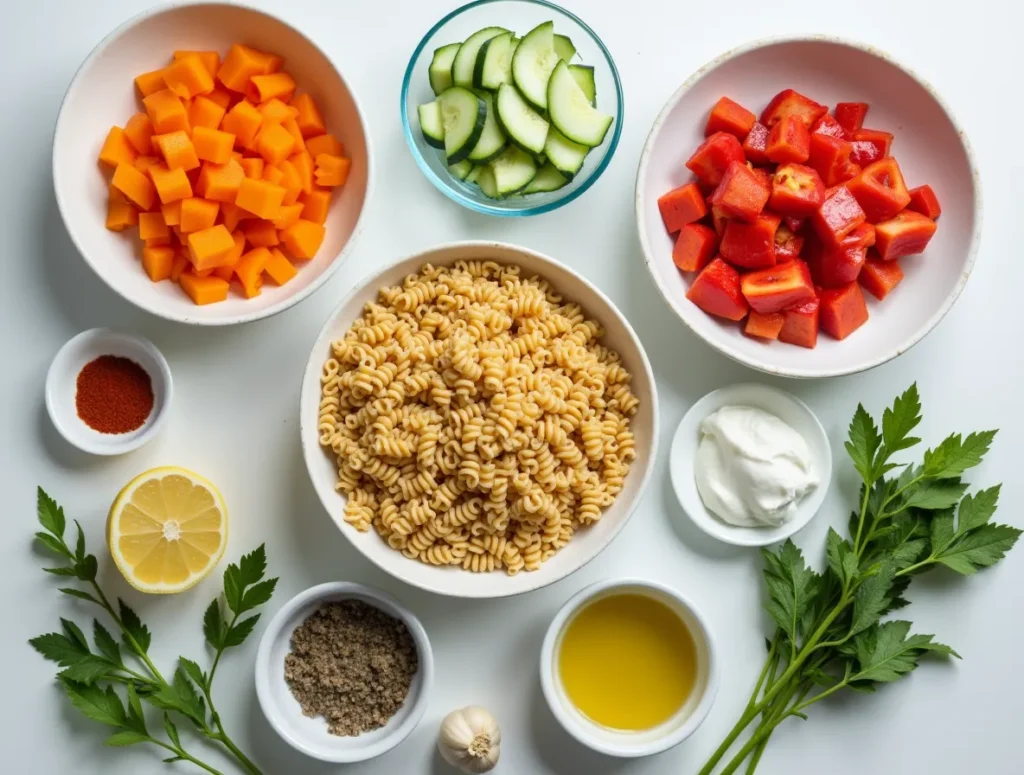
How to Make a High Protein Pasta Salad Step-by-Step
Step 1 – Cook the Protein-Rich Pasta
Start by boiling your choice of high-protein pasta according to the package instructions. Legume-based pastas like chickpea or lentil pasta may foam slightly during boiling—this is completely normal. Be sure to salt the water generously to add flavor from the inside out..Cucumber Salad Recipes
Once cooked, drain and rinse with cold water. Rinsing stops the cooking process and cools the pasta instantly, which helps preserve its texture for salad.
Pro Tip: Don’t overcook the pasta—slightly al dente pasta holds up better when tossed with dressing and other ingredients.
Step 2 – Prepare the Protein Sources
While the pasta is cooking, prepare your protein:
- Grill or bake seasoned chicken breasts and slice into strips.
- Boil eggs to your desired doneness (typically 10–12 minutes for hard-boiled).
- Drain and rinse canned beans or chickpeas.
- Sauté tofu or tempeh in a skillet until golden and crispy.
- Open and flake canned tuna or salmon.
Having multiple protein options adds complexity and keeps the salad interesting.
Step 3 – Chop the Veggies
Wash and dice your fresh vegetables into bite-sized pieces. Keep texture in mind—crunchy veggies like bell peppers and cucumbers provide contrast against the soft pasta and proteins. For extra flavor, try roasting some vegetables like zucchini, mushrooms, or sweet potatoes.
Step 4 – Mix the Dressing
Choose your dressing based on dietary needs and flavor preferences. A simple Greek yogurt dressing recipe includes:
- ½ cup plain Greek yogurt
- 1 tablespoon olive oil
- Juice of 1 lemon
- 1 teaspoon Dijon mustard
- 1 garlic clove, minced
- Salt and pepper to taste
Whisk together until smooth. Taste and adjust seasoning as needed.
Step 5 – Combine All Ingredients
In a large mixing bowl, add your cooled pasta, proteins, vegetables, and any extras like olives or cheese. Pour the dressing over the top and gently toss to combine.
Let it rest for at least 15–30 minutes in the refrigerator before serving. This gives the flavors time to develop and meld together.
Customizing Your High Protein Pasta Salad
For Vegetarians and Vegans
- Use lentil or chickpea pasta.
- Choose tofu, tempeh, edamame, or legumes as the protein base.
- Skip cheese or use a plant-based alternative.
- Use tahini, olive oil, or avocado-based dressings.
For Low-Carb Dieters
- Opt for low-carb pasta alternatives made with konjac root or cauliflower.
- Increase the protein and vegetable ratio.
- Use lean meats, eggs, and cheese for a keto-friendly version.
- Watch dressing ingredients—avoid honey or sugar-based vinaigrettes.
For Mediterranean Diet Lovers
- Use whole wheat or quinoa pasta.
- Add grilled chicken, olives, feta, tomatoes, cucumbers, and a drizzle of olive oil.
- Include herbs like oregano, basil, and parsley.
- Pair with a lemon-olive oil vinaigrette for a fresh taste.
Storing and Serving Tips
Refrigeration Tips
High protein pasta salad stores exceptionally well in the fridge. Place it in an airtight container and refrigerate for up to 4 days. If using greens like arugula or spinach, store them separately and mix just before serving to avoid wilting.
Can You Freeze It?
While you can freeze pasta salad, it’s not ideal. Freezing can affect the texture of both pasta and vegetables. However, you can prep individual ingredients in bulk—like cooked chicken or beans—and freeze those to quickly assemble fresh salads later.
Best Ways to Serve
- Meal Prep: Divide into lunch containers for easy weekday meals.
- Potlucks & Picnics: Chill in a cooler and serve outdoors—just be mindful of perishable proteins like eggs and dairy.
- Post-Workout Meal: Add a boiled egg and pair with a protein smoothie for full recovery.
- Dinner Side Dish: Serve alongside grilled meats or seafood for a complete dinner.
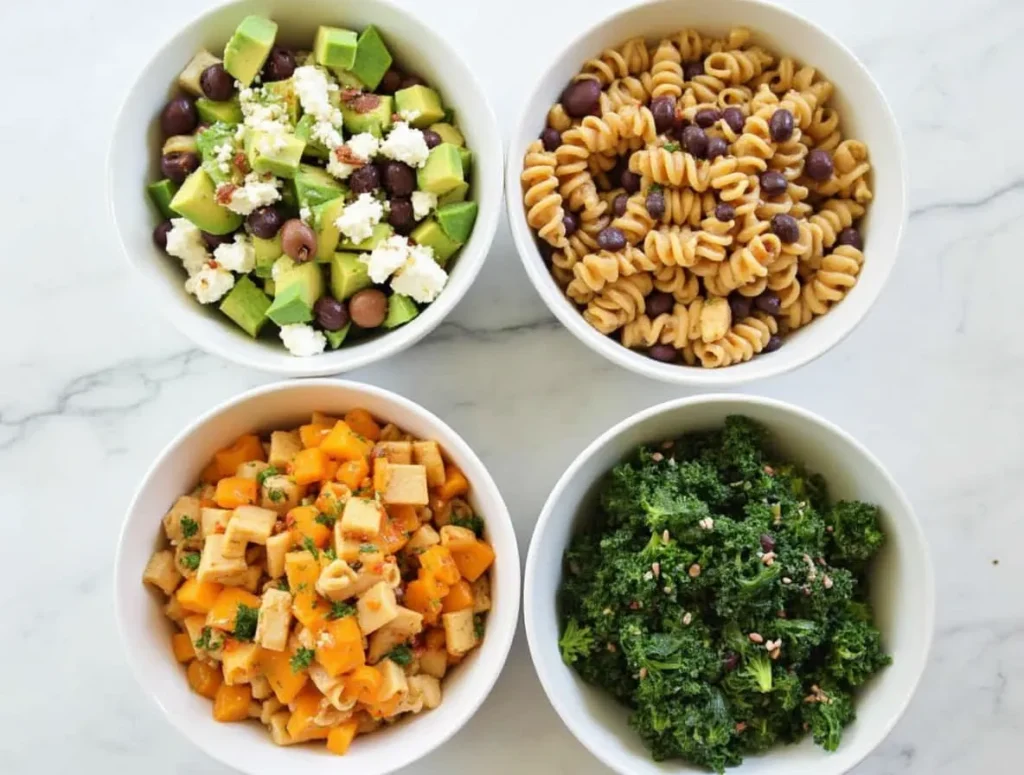
Flavor Variations and Seasonal Twists
Mediterranean High Protein Pasta Salad
If you’re craving sun-kissed flavors, the Mediterranean version is a must-try. It’s rich in heart-healthy fats and full of vibrant, herbaceous notes.
Key Ingredients:
- Chickpea or whole wheat pasta
- Grilled chicken or tuna
- Cherry tomatoes, cucumbers, red onions
- Kalamata olives, crumbled feta
- Fresh parsley, oregano
- Dressing: olive oil, lemon juice, garlic
This combo is not only flavorful but also aligns well with the Mediterranean diet, known for its anti-inflammatory benefits.
Spicy Southwest Protein Pasta Salad
Want a little kick? Go bold with a Tex-Mex twist.
Key Ingredients:
- Black bean or quinoa pasta
- Grilled steak, chicken, or black beans
- Corn, black beans, diced bell peppers
- Avocado chunks, chopped cilantro
- Dressing: lime juice, olive oil, cumin, chipotle powder
Top it off with a dash of hot sauce or jalapeño slices if you love the heat!
Asian-Inspired High Protein Pasta Salad
For those who enjoy sesame and soy-based flavors, an Asian variation brings something different to the table.
Key Ingredients:
- Edamame pasta or soba noodles (for extra protein)
- Tofu or grilled shrimp
- Shredded carrots, snow peas, green onions
- Crushed peanuts or sesame seeds
- Dressing: soy sauce, sesame oil, rice vinegar, a hint of ginger
You can even serve it warm for a unique twist on the traditional cold salad format.
Autumn-Inspired Pasta Salad
Perfect for cozy fall days, this version uses seasonal produce and warm spices.
Key Ingredients:
- Whole wheat pasta
- Roasted butternut squash or sweet potatoes
- Grilled turkey or tempeh
- Kale or baby spinach
- Pumpkin seeds, dried cranberries
- Dressing: maple Dijon vinaigrette
The contrast of sweet and savory, warm and cool makes this a crowd-pleaser during the cooler months.
Pro Tips from Nutritionists and Chefs
Balance Texture and Flavor
Chefs agree: a great salad has multiple textures. Use crunchy veggies, creamy dressings, firm proteins, and al dente pasta to create contrast. Aim for at least three different textures to make every bite interesting.
Let It Marinate
If you have the time, let your pasta salad chill in the fridge for at least an hour. This marination time allows the dressing to soak into the pasta and meld with the vegetables, resulting in a deeper, richer flavor.
Season Every Layer
Don’t just rely on your dressing to carry the flavor. Lightly season each layer—especially your proteins and veggies—with salt, pepper, and spices to enhance the overall taste.
Keep the Dressing Separate for Meal Prep
If you’re storing the salad for more than a couple of days, consider keeping the dressing in a separate container and mixing it just before eating. This prevents sogginess and keeps the salad fresh.
Make It Colorful
Use a wide variety of colorful vegetables. Not only does this make the dish more visually appealing, but it also boosts nutritional diversity. Remember: more colors on your plate often mean a wider range of nutrients.
Use Fresh Herbs Generously
Don’t underestimate the power of herbs. Fresh basil, cilantro, dill, or parsley can completely transform the flavor profile of your salad without adding extra calories.
Common Mistakes to Avoid When Making High Protein Pasta Salad
Using the Wrong Type of Pasta
One of the biggest mistakes is using soft, overcooked pasta or low-protein options like white pasta. These don’t hold their shape and provide little nutritional value. Instead, go for firm, high-protein options like chickpea, lentil, or whole wheat pasta, and cook them al dente for best results.
Overdressing the Salad
Too much dressing can make your salad soggy, mask the flavor of the ingredients, and add unnecessary calories. Start with a small amount of dressing and gradually add more while tossing to coat evenly.
Skipping the Seasoning
Even healthy pasta salads need seasoning. A pinch of sea salt, fresh ground pepper, and herbs can make a world of difference. Don’t forget to season the individual components (like grilled chicken or roasted veggies) before combining them.
Not Letting the Salad Rest
Skipping the rest period after mixing can leave you with bland-tasting pasta. Allowing your salad to chill for 20–30 minutes lets all the flavors come together, enhancing taste and texture.
Forgetting Protein Variety
Using only one protein source can make your salad boring. Mix it up! Pair chicken with beans, tofu with edamame, or eggs with cheese to build a richer, more filling dish.
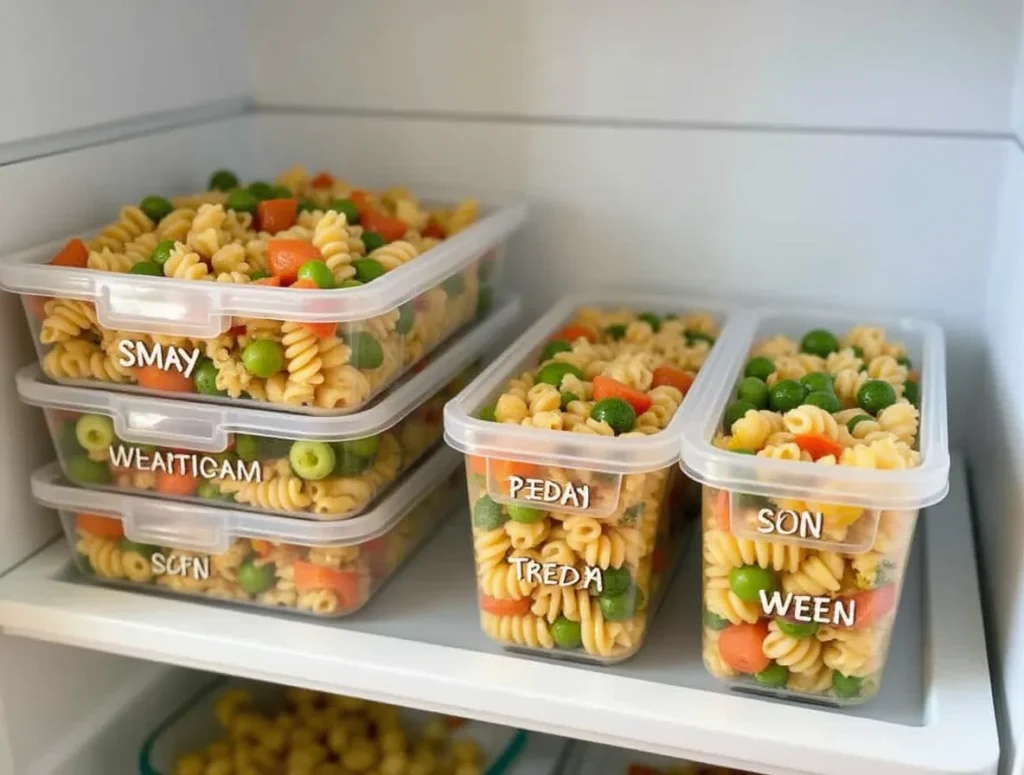
Bonus Tips for Next-Level Pasta Salads
Add a Crunch Element
Incorporate roasted seeds, chopped nuts, or air-fried chickpeas to add an extra layer of crunch. This improves texture and adds extra nutrients like healthy fats and minerals.
Use Leftovers Creatively
Got leftover grilled meat or roasted veggies? Toss them into your pasta salad. It’s a great way to reduce waste and create new flavor combinations.
Make It a Full Meal
Pair your high protein pasta salad with a smoothie, a piece of fruit, or a protein bar for a complete meal that covers all macronutrients.
Turn It into a Wrap or Bowl
Spoon your pasta salad into a large lettuce leaf or whole grain wrap for a portable lunch option. Or layer it with greens in a bowl for a fresh, Instagram-worthy meal.
FAQ
Is high protein pasta salad good for weight loss?
Yes! It combines protein, fiber, and healthy fats, which help keep you full longer. Using lean proteins and whole ingredients keeps calories in check while supporting muscle maintenance and fat loss.
How much protein is in a typical high protein pasta salad?
Depending on the ingredients, a single serving (1.5–2 cups) can contain anywhere from 20–35 grams of protein, especially when made with chickpea pasta, chicken, beans, and cheese.
Can I make a vegan high protein pasta salad?
Absolutely! Use plant-based pasta and add tofu, tempeh, chickpeas, or edamame for protein. Dress with tahini, lemon juice, or a dairy-free yogurt dressing for flavor and creaminess.
How long does high protein pasta salad last in the fridge?
Stored in an airtight container, it lasts up to 4 days. For best texture and flavor, keep dressing and greens separate until just before serving.
Can I use canned ingredients in the salad?
Yes! Canned beans, corn, tuna, or chickpeas are convenient and protein-rich. Just rinse thoroughly to reduce sodium and improve taste.
What’s the best pasta for gluten-free high protein salads?
Go for chickpea, lentil, or quinoa-based gluten-free pasta. These offer both protein and fiber while being easy on the digestive system.
Conclusion
The high protein pasta salad is more than just a meal—it’s a lifestyle-friendly, nutrition-packed powerhouse that fits a variety of dietary needs. Whether you’re bulking, cutting, meal-prepping, or just looking for a refreshing and satisfying lunch, this dish is your go-to solution. With customizable ingredients, bold flavor profiles, and nutrient-dense benefits, it’s easy to understand why it’s trending on Google and showing up on health-focused food blogs across the web.
Remember, balance is key: pairing high-quality proteins with fiber-rich vegetables, healthy fats, and smart carbs creates a complete meal. And the best part? It doesn’t take long to prepare and stores beautifully in the fridge for several days—making your week smoother and healthier.
Don’t forget to experiment with seasonal vegetables, different proteins, and diverse dressings to keep it exciting and personalized. Whether you stick to the classic Mediterranean combo or branch out with spicy Southwest flavors, a good pasta salad recipe is something every home cook should keep in their back pocket.
Try it once, and you’ll be hooked on the ease, taste, and benefits of this ultimate high-protein dish. Happy prepping!
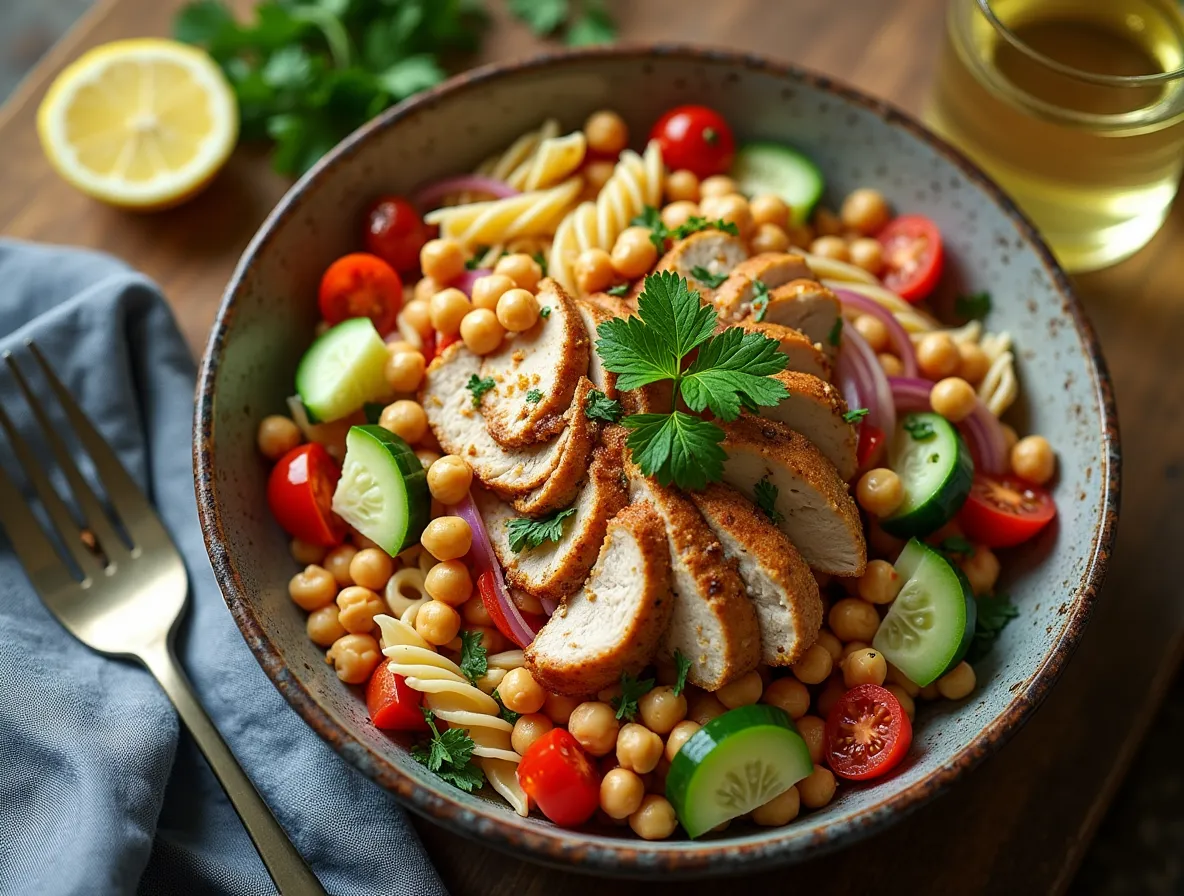
Name: High Protein Pasta Salad
Ingredients
Equipment
Method
- Instructions:
- Cook pasta according to package instructions. Drain, rinse with cold water, and set aside.
- Make dressing by whisking together Greek yogurt, olive oil, lemon juice, mustard, minced garlic, salt, and pepper.
- Combine cooked pasta, chicken, chickpeas, tomatoes, cucumber, bell pepper, onion, and feta in a large bowl.
- Pour dressing over the salad and toss until well combined.
- Chill in the fridge for 15–30 minutes before serving for best flavor.
- Garnish with fresh herbs before serving.

